A Sine Function Can Be Used to Model Light Waves 530
Thunderstruck!

Where did the Australian rock band Air-conditioning/DC get their proper name from? Why, Alternating Current and Direct Current, of course! Both AC and DC describe types of current period in a excursion. In directly current (DC), the electric charge (electric current) only flows in one direction. Electric charge in alternating current (Ac), on the other manus, changes direction periodically. The voltage in AC circuits also periodically reverses considering the current changes direction.
Most of the digital electronics that you build will use DC. Withal, it is important to understand some Ac concepts. Most homes are wired for AC, and then if you plan to connect your Tardis music box projection to an outlet, you will need to convert Air-conditioning to DC. AC also has some useful backdrop, such as existence able to convert voltage levels with a unmarried component (a transformer), which is why AC was chosen equally the primary ways to transmit electricity over long distances.
What Yous Will Larn
- The history behind AC and DC
- Different ways to generate Air conditioning and DC
- Some examples of AC and DC applications
Recommended Reading
- What is Electricity
- What is a Excursion?
- Voltage, Current, Resistance, and Ohm'southward Police
- Electric Ability
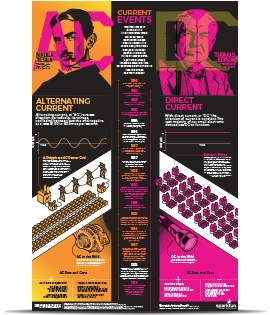
Alternating Current (Ac)
Alternating current describes the flow of charge that changes direction periodically. Every bit a upshot, the voltage level also reverses along with the current. AC is used to evangelize power to houses, office buildings, etc.
Generating Air-conditioning
AC tin be produced using a device chosen an alternator. This device is a special type of electrical generator designed to produce alternating electric current.
A loop of wire is spun inside of a magnetic field, which induces a current forth the wire. The rotation of the wire can come from whatever number of ways: a wind turbine, a steam turbine, flowing h2o, and and then on. Because the wire spins and enters a different magnetic polarity periodically, the voltage and electric current alternates on the wire. Here is a short animation showing this principle:
(Video credit: Khurram Tanvir)
Generating AC can be compared to our previous water analogy:
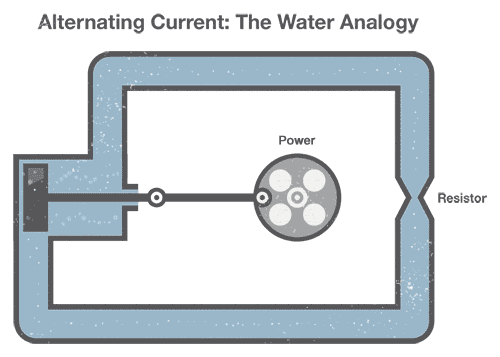
To generate Air conditioning in a ready of water pipes, we connect a mechanical crank to a piston that moves water in the pipes dorsum and forth (our "alternating" current). Notice that the pinched section of pipe however provides resistance to the flow of water regardless of the management of flow.
Waveforms
Air conditioning can come in a number of forms, equally long as the voltage and electric current are alternating. If we claw up an oscilloscope to a circuit with Air-conditioning and plot its voltage over time, we might see a number of different waveforms. The most mutual blazon of Air-conditioning is the sine wave. The Air conditioning in most homes and offices have an oscillating voltage that produces a sine wave.
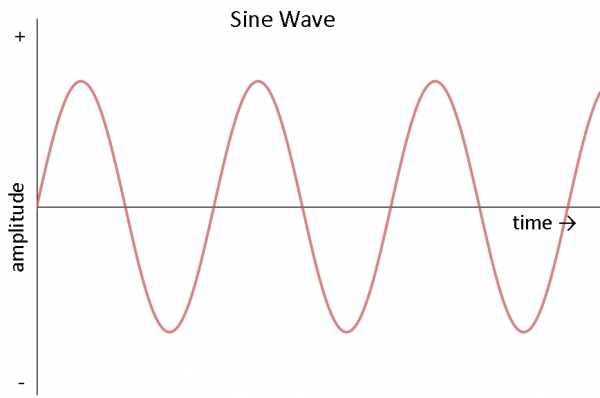
Other common forms of AC include the square wave and the triangle wave:
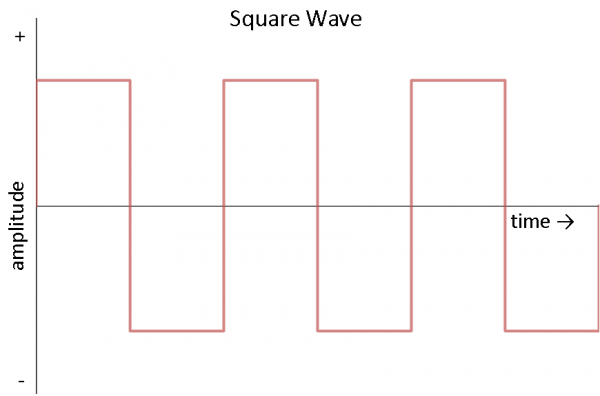
Foursquare waves are oft used in digital and switching electronics to test their operation.
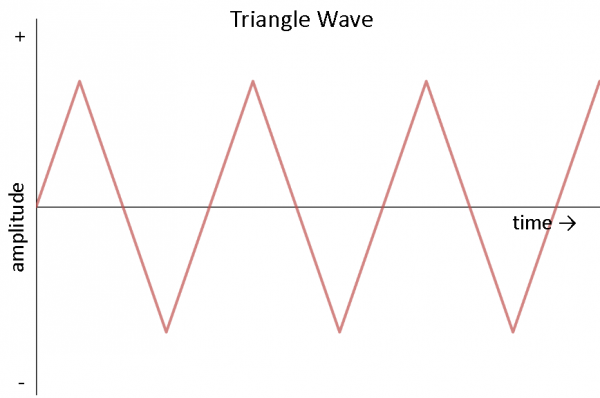
Triangle waves are found in sound synthesis and are useful for testing linear electronics like amplifiers.
Describing a Sine Moving ridge
We often want to describe an AC waveform in mathematical terms. For this example, we will use the common sine moving ridge. There are three parts to a sine moving ridge: aamplitude, frequency, and phase.
Looking at just voltage, we can draw a sine wave as the mathematical function:

5(t) is our voltage as a part of time, which means that our voltage changes every bit time changes. The equation to the right of the equals sign describes how the voltage changes over time.
VP is the aamplitude. This describes the maximum voltage that our sine moving ridge tin can reach in either direction, meaning that our voltage tin can exist +VP volts, -VP volts, or somewhere in betwixt.
The sin() function indicates that our voltage will be in the grade of a periodic sine wave, which is a smooth oscillation around 0V.
2π is a abiding that converts the freqency from cycles (in hertz) to angular frequnecy (radians per second).
f describes the frequency of the sine wave. This is given in the grade of hertz or units per 2d. The frequency tells how many times a item wave form (in this example, ane cycle of our sine wave - a ascension and a autumn) occurs within 1 second.
t is our independent variable: time (measured in seconds). As time varies, our waveform varies.
φ describes the phase of the sine wave. Stage is a measure of how shifted the waveform is with respect to time. Information technology is often given as a number betwixt 0 and 360 and measured in degrees. Considering of the periodic nature of the sine moving ridge, if the wave form is shifted by 360° it becomes the same waveform again, as if it was shifted by 0°. For simplicity, we sill assume that stage is 0° for the rest of this tutorial.
We tin can turn to our trusty outlet for a expert example of how an Air-conditioning waveform works. In the United States, the power provided to our homes is AC with about 170V zero-to-elevation (amplitude) and 60Hz (frequency). We can plug these numbers into our formula to get the equation (recollect that we are assuming our stage is 0):

We can utilise our handy graphing calculator to graph this equation. If no graphing calculator is available we tin can use a free online graphing program like Desmos (Note that you might have to apply 'y' instead of 'v' in the equation to come across the graph).
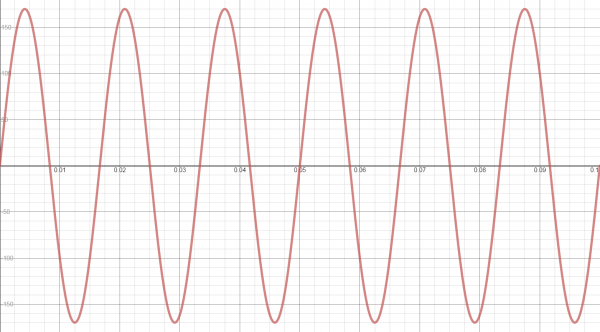
Observe that, equally we predicted, the voltage rise upward to 170V and down to -170V periodically. Additionally, 60 cycles of the sine wave occurs every second. If we were to mensurate the voltage in our outlets with an oscilloscope, this is what we would run across (WARNING: do not attempt to mensurate the voltage in an outlet with an oscilloscope! This will likely impairment the equipment).
Annotation: You might take heard that Ac voltage in the US is 120V. This is as well correct. How? When talking about Air-conditioning (since the voltage changes constantly), it is oft easier to utilize an average or mean. To accomplish that, nosotros use a method chosen "Root mean squared." (RMS). Information technology is ofttimes helpful to employ the RMS value for Air conditioning when you want to summate electrical ability. Even though, in our example, nosotros had the voltage varying from -170V to 170V, the root hateful square is 120V RMS.
Applications
Domicile and office outlets are almost always Ac. This is considering generating and transporting AC beyond long distances is relatively easy. At loftier voltages (over 110kV), less energy is lost in electrical power manual. Higher voltages mean lower currents, and lower currents mean less estrus generated in the power line due to resistance. AC can be converted to and from high voltages easily using transformers.
AC is as well capable of powering electric motors. Motors and generators are the verbal aforementioned device, but motors convert electrical energy into mechanical energy (if the shaft on a motor is spun, a voltage is generated at the terminals!). This is useful for many large appliances similar dishwashers, refrigerators, so on, which run on AC.
Direct Current (DC)
Straight current is a bit easier to understand than alternating current. Rather than oscillating back and forth, DC provides a constant voltage or current.
Generating DC
DC can be generated in a number of ways:
- An AC generator equipped with a device called a "commutator" tin produce straight current
- Employ of a device chosen a "rectifier" that converts AC to DC
- Batteries provide DC, which is generated from a chemical reaction inside of the battery
Using our water illustration again, DC is similar to a tank of water with a hose at the stop.
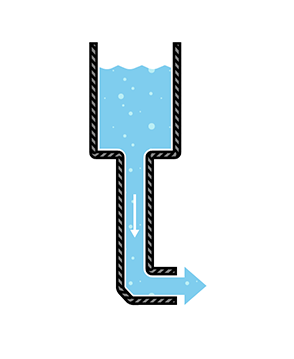
The tank can only push water i style: out the hose. Like to our DC-producing battery, once the tank is empty, water no longer flows through the pipes.
Describing DC
DC is defined every bit the "unidirectional" menses of current; current only flows in one management. Voltage and current can vary over time so long every bit the direction of flow does non change. To simplify things, we will presume that voltage is a constant. For example, we assume that a AA battery provides ane.5V, which can be described in mathematical terms equally:

If we plot this over time, we see a constant voltage:
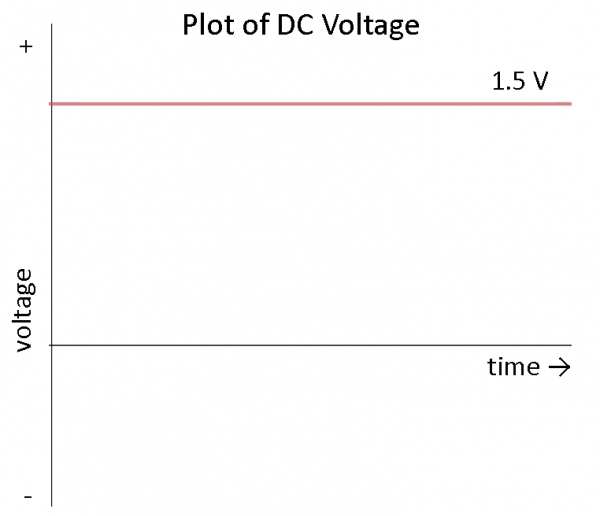
What does this hateful? Information technology means that nosotros can count on most DC sources to provide a constant voltage over time. In reality, a battery will slowly lose its charge, meaning that the voltage will drop as the battery is used. For most purposes, we can assume that the voltage is constant.
Applications
About all electronics projects and parts for sale on SparkFun run on DC. Everything that runs off of a bombardment, plugs in to the wall with an AC adapter, or uses a USB cable for ability relies on DC. Examples of DC electronics include:
- Prison cell phones
- The LilyPad-based D&D Dice Gauntlet
- Flat-screen TVs (Air conditioning goes into the TV, which is converted to DC)
- Flashlights
- Hybrid and electrical vehicles
Boxing of the Currents
Almost every dwelling house and business is wired for AC. Still, this was not an overnight decision. In the late 1880s, a diversity of inventions beyond the United States and Europe led to a full-scale battle betwixt alternating current and directly current distribution.
In 1886, Ganz Works, an electric company located in Budapest, electrified all of Rome with Air conditioning. Thomas Edison, on the other hand, had synthetic 121 DC power stations in the United states by 1887. A turning bespeak in the battle came when George Westinghouse, a famous industrialist from Pittsburgh, purchased Nikola Tesla'southward patents for Ac motors and transmission the next year.
AC vs. DC
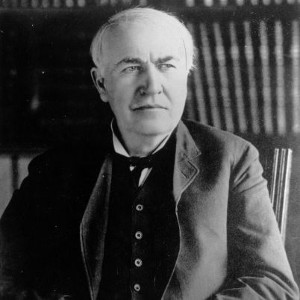
Thomas Edison (Paradigm courtesy of biography.com)
In the late 1800s, DC could not be easily converted to high voltages. As a outcome, Edison proposed a system of small, local power plants that would power individual neighborhoods or city sections. Power was distributed using three wires from the power establish: +110 volts, 0 volts, and -110 volts. Lights and motors could be connected between either the +110V or 110V socket and 0V (neutral). 110V allowed for some voltage drop between the constitute and the load (abode, office, etc.).
Even though the voltage drop beyond the power lines was accounted for, power plants needed to be located inside 1 mile of the end user. This limitation made power distribution in rural areas extremely difficult, if non incommunicable.
With Tesla'due south patents, Westinghouse worked to perfect the AC distribution system. Transformers provided an inexpensive method to step up the voltage of AC to several thousand volts and dorsum down to usable levels. At higher voltages, the aforementioned power could be transmitted at much lower current, which meant less power lost due to resistance in the wires. Every bit a issue, large power plants could be located many miles away and service a greater number of people and buildings.
Edison's Smear Campaign
Over the next few years, Edison ran a campaign to highly discourage the employ of AC in the United States, which included lobbying state legislatures and spreading disinformation almost Ac. Edison also directed several technicians to publicly electrocute animals with AC in an attempt to show that AC was more dangerous than DC. In try to display these dangers, Harold P. Brownish and Arthur Kennelly, employees of Edison, designed the get-go electric chair for the land of New York using Air conditioning.
The Rise of Air conditioning
In 1891, the International Electro-Technical Exhibition was held in Frankfurt, Germany and displayed the first long distance transmission of three-stage AC, which powered lights and motors at the exhibition. Several representatives from what would become General Electrical were present and were subsequently impressed by the display. The following year, General Electric formed and began to invest in AC engineering science.
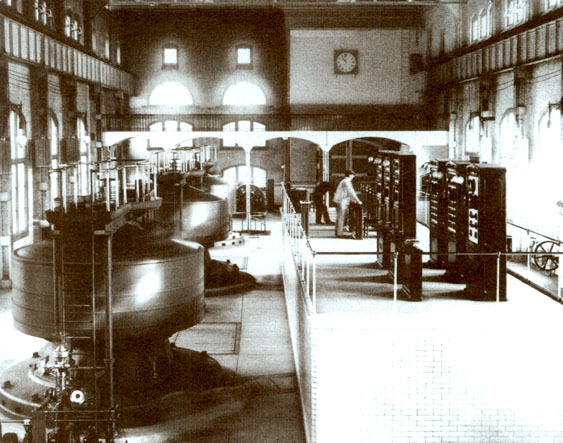
Edward Dean Adams Power Found at Niagara Falls, 1896 (Prototype courtesy of teslasociety.com)
Westinghouse won a contract in 1893 to build a hydroelectric dam to harness the ability of Niagara falls and transmit AC to Buffalo, NY. The project was completed on November sixteen, 1896 and Air-conditioning power began to power industries in Buffalo. This milestone marked the turn down of DC in the United States. While Europe would adopt an Air-conditioning standard of 220-240 volts at l Hz, the standard in N America would get 120 volts at 60 Hz.
High-Voltage Direct Current (HVDC)
Swiss engineer René Thury used a series of motor-generators to create a loftier-voltage DC organisation in the 1880s, which could exist used to transmit DC power over long distances. All the same, due to the high cost and maintenance of the Thury systems, HVDC was never adopted for almost a century.
With the invention of semiconductor electronics in the 1970s, economically transforming between Air-conditioning and DC became possible. Specialized equipment could be used to generate high voltage DC power (some reaching 800 kV). Parts of Europe have begun to employ HVDC lines to electrically connect various countries.
HVDC lines feel less loss than equivalent Air conditioning lines over extremely long distances. Additionally, HVDC allows different AC systems (e.g. l Hz and 60 Hz) to be connected. Despite its advantages, HVDC systems are more costly and less reliable than the mutual AC systems.
In the finish, Edison, Tesla, and Westinghouse may have their wishes come up truthful. Air conditioning and DC can coexist and each serve a purpose.
Resources and Going Farther
You should now have a good agreement of the differences betwixt Air-conditioning and DC. AC is easier to transform betwixt voltage levels, which makes high-voltage manual more feasible. DC, on the other hand, is establish in most all electronics. You should know that the 2 do not mix very well, and y'all volition need to transform Ac to DC if yous wish to plug in most electronics into a wall outlet. With this understanding, y'all should be set to tackle some more complex circuitry and concepts, even if they contain AC.
Take a wait at the following tutorials when you are set up to dive deeper into the world of electronics:
- Series and Parallel Circuits
- Logic Levels
- How to Utilise a Multimeter
- How to Power a Projection
Source: https://learn.sparkfun.com/tutorials/alternating-current-ac-vs-direct-current-dc/all

0 Response to "A Sine Function Can Be Used to Model Light Waves 530"
Post a Comment